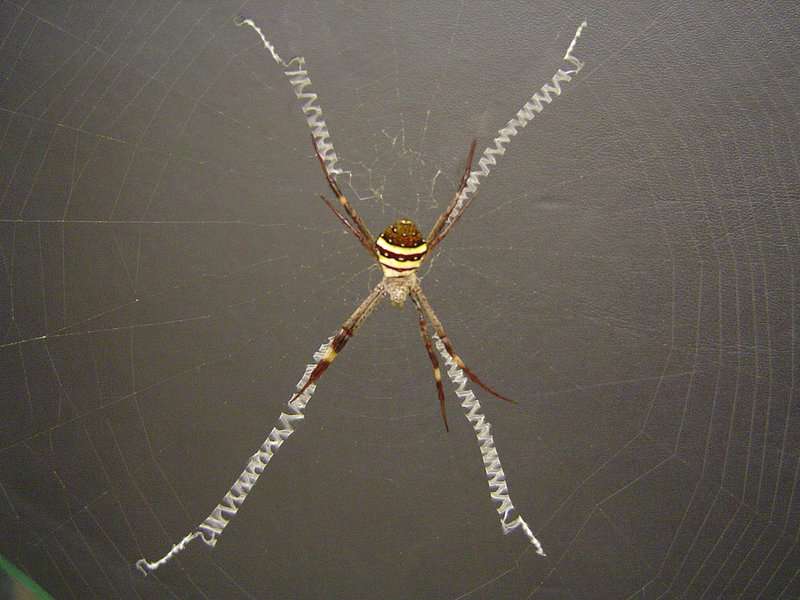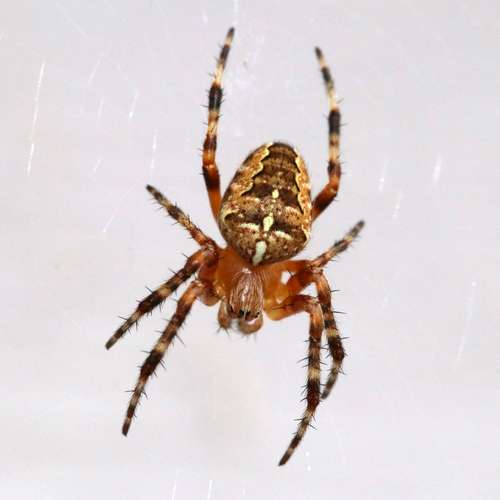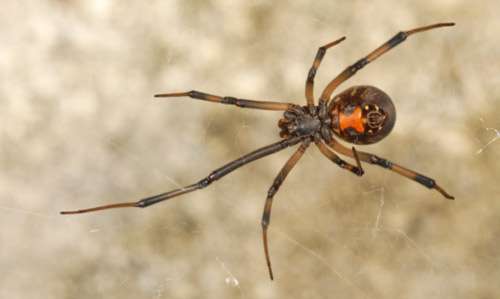
An orb-web spider species called Argiope keyserlingi can be found in northern Queensland and Victoria along Australia’s east coast. It resembles Argiope aetherea, a species from north Queensland that is closely related, in appearance. Large populations of A. keyserlingi are frequently found in suburban parks and gardens, especially amid the leaves of Lomandra longifolia. A. keyserlingi has significant sexual dimorphism, like many other orb-web spider species, with the females being significantly bigger than the males. In the summer, mature females are visible, and it’s not unusual to observe several males sharing a single female’s web.
Due to its ability to construct silk bands into the arms of an X-shaped cross resembling the one on which St. Andrew is believed to have been crucified, A. keyserlingi is also known as the St. Andrew’s cross spider. This species’ juveniles may weave a silk design in the form of a spiral. These bands, also known as stabilimenta or web ornaments, are supposed to boost the species’ prey capture rate, but as in other species, it has been discovered that they also shield the spider from predators.
A. keyserlingi is a crucial model species in research on the behavior and ecology of spiders. Researchers have used this species to study sexual size dimorphism, sperm competition, cryptic female choice, the effect of pheromones in mating behavior, and the development of web decorations.
Description
The size of the species’ females ranges from 10 to 16 mm. Their shiny carapaces include two horizontal yellow belts underneath and bands of silver, yellow, red, and black on their upper half. Males of the species typically range in size from 3 to 4 mm. They have a glossy brown hue. Spiders that form the A. keyserlingi rest with their legs arranged in pairs.

Geographical Distribution and Habitat
Eastern Australia’s rainforest borders, open woods, and heathlands are where they primarily find St Andrew’s cross spiders. The northern portion of the Northern Territory, the northern portion of Tasmania, the western portion of Western Australia, the area around the Tedi River in Papua New Guinea, the Malekula island of Vanuatu, every area of Lord Howe Island, and even the area around the Shihe-Shiguan River in China are other places where they can be found. On low, shrubby plants, they build medium-sized webs.
Diet
Flies, moths, butterflies, bees, and other insects are among this spider’s prey. Prioritizing smaller prey, the orb-weaver wraps its victim in flawless silk before digesting it.
Reproduction
Male small St Andrew’s cross spiders face danger during mating season, which lasts from summer to autumn. Males gravitate toward the upper portion of the web; some of them may even be lacking legs as a result of meeting unwelcoming females. Then creates a mating thread by the male within the web, which he oscillates to draw the welcoming female. Because egg sacs are the preferred food of wasps and flies, the female then suspends her pear-shaped sac in a web of threads, frequently encircled by leaves to conceal the silky green material of the sac.
Web
Its web is made up of meandering, silken ribbons that are bluish-white and can either create a whole or partial cross in the middle of the web. Biologists have long been baffled by the function of the stabilimentum, which resembles a crucifix. Initially, they believed that the stabilimentum served to reinforce the web. Other theories link it to catching prey or avoiding its predators, but the stabilmentum’s function is still unknown. The stabilimentum has the ability to reflect ultraviolet light well, which attracts flying insects. According to biologists, this may be done to improve its chances of grabbing its prey.
For daytime predators, particularly birds and wasps, the web and the spider are visible because of the stabilmentum’s architecture. This ornament can take one of three different forms: a full cross, a half cross with one to three arms, or infrequently nothing at all. For predators, this variety may make it difficult to recognize webs. Additionally, biologists discovered a potential use for the stabilimentum as a predator deterrent.
As Pet
Enclosure
These spiders thrive in mesh enclosures because they have enough room to build their webs without being able to scurry away. At most 30cm x 30cm x 30cm would be the minimum size for a decent enclosure. Another way to encourage these spiders to build a web is by placing them in a “orbframe,” a free-standing frame with two branches sticking out from the base. “Bugs Alive – A Guide to preserving Australian invertebrates” is a good resource for more details. Allow the spider to attach its silk to one branch, then carefully lead it to the opposite branch to attach a line of silk between the two branches. This will position the spider in the appropriate position.
Feeding
Live insects for food. The best insects are flies, crickets, cockroaches, and moths. The size of the meal insects shouldn’t be more than one-third that of your spider. This spider prefers to trap its prey inside its web since it builds its own. Although feeding twice a week is advised, baby spiders will require more frequent feedings as they develop.
Water
Every other day, lightly mist the area around your spider with water; it will sip the droplets from the web.
Temperature
This species can endure temperatures between 8° and 30° for brief durations, however the safe range for them is 18° to 26°C.
Table





